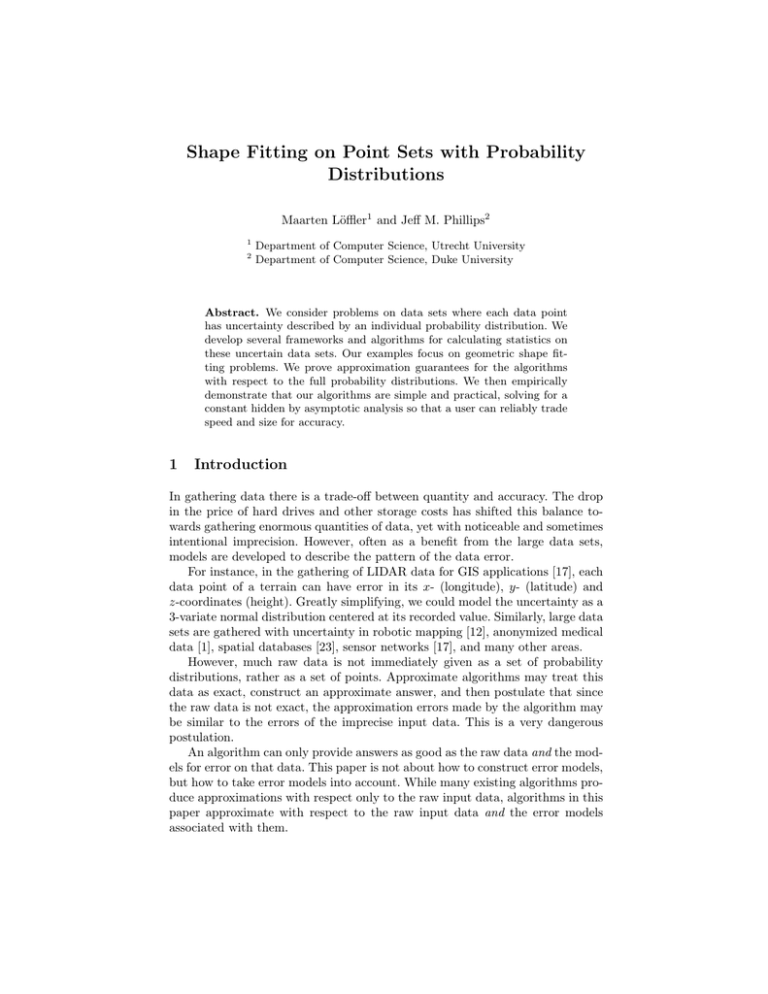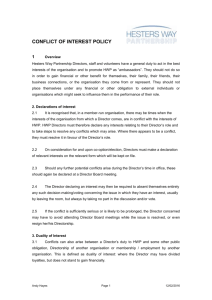Shape Fitting on Point Sets with Probability Distributions Maarten L¨offler
advertisement

Shape Fitting on Point Sets with Probability
Distributions
Maarten Löffler1 and Jeff M. Phillips2
1
2
Department of Computer Science, Utrecht University
Department of Computer Science, Duke University
Abstract. We consider problems on data sets where each data point
has uncertainty described by an individual probability distribution. We
develop several frameworks and algorithms for calculating statistics on
these uncertain data sets. Our examples focus on geometric shape fitting problems. We prove approximation guarantees for the algorithms
with respect to the full probability distributions. We then empirically
demonstrate that our algorithms are simple and practical, solving for a
constant hidden by asymptotic analysis so that a user can reliably trade
speed and size for accuracy.
1
Introduction
In gathering data there is a trade-off between quantity and accuracy. The drop
in the price of hard drives and other storage costs has shifted this balance towards gathering enormous quantities of data, yet with noticeable and sometimes
intentional imprecision. However, often as a benefit from the large data sets,
models are developed to describe the pattern of the data error.
For instance, in the gathering of LIDAR data for GIS applications [17], each
data point of a terrain can have error in its x- (longitude), y- (latitude) and
z-coordinates (height). Greatly simplifying, we could model the uncertainty as a
3-variate normal distribution centered at its recorded value. Similarly, large data
sets are gathered with uncertainty in robotic mapping [12], anonymized medical
data [1], spatial databases [23], sensor networks [17], and many other areas.
However, much raw data is not immediately given as a set of probability
distributions, rather as a set of points. Approximate algorithms may treat this
data as exact, construct an approximate answer, and then postulate that since
the raw data is not exact, the approximation errors made by the algorithm may
be similar to the errors of the imprecise input data. This is a very dangerous
postulation.
An algorithm can only provide answers as good as the raw data and the models for error on that data. This paper is not about how to construct error models,
but how to take error models into account. While many existing algorithms produce approximations with respect only to the raw input data, algorithms in this
paper approximate with respect to the raw input data and the error models
associated with them.
Geometric error models. An early model for imprecise geometric data, motivated by finite precision of coordinates, is ε-geometry [14], where each data point
is known to lie within a ball of radius ε. This models has been used to study the
robustness of problems such as the Delaunay triangulation [6, 18]. This model
has been extended to allow different uncertainty regions around each point for
object intersection [21] and shape-fitting problems [24]. These approaches give
worst case bounds on error, for instance upper and lower bounds on the radius
of the minimum enclosing ball. But when uncertainty is given as a probability
distribution, then these approaches must use a threshold to truncate the distribution. Furthermore, the answers in this model are quite dependent on the
boundary of the uncertainty region, while the true location is likely to be in the
interior. This paper thus describes how to use the full probability distribution
describing the uncertainty, and to only discretize, as desired, the probability
distribution of the final solution.
The database community has focused on similar problems for usually onedimensional data such as indexing [2], ranking [11], and creating histograms [10].
1.1
Problem Statement
Let µp : Rd R → R+ describe the probability distribution of a point p where
the integral q∈Rd µp (q) dq = 1. Let µP : Rd × Rd × . . . × Rd → R+ describe
the distribution of a point set P by the joint probability over each p ∈ P .
d
d
dn
For brevity we write the space
Qn R × . . . × R as R . For this paper we will
assume µP (q1 , q2 , . . . , qn ) = i=1 µpi (qi ), so the distribution for each point is
independent, although this restriction can be easily circumvented.
Given a distribution µP we ask a variety of shape fitting questions about the
uncertain point set. For instance, what is the radius of the smallest enclosing ball
or what is the smallest axis-aligned bounding box of an uncertain point set. In
the presence of imprecision, the answer to such a question is not a single value or
structure, but also a distribution of answers. The focus of this paper is not just
how to answer such shape fitting questions about these distributions, but how
to concisely represent them. As a result, we introduce two types of approximate
distributions as answers, and a technique to construct coresets for these answers.
ε-Quantizations. Let f : Rdn → Rk be a function on a fixed point set. Examples
include the radius of the minimum enclosing ball where k = 1 and the width
of the minimum enclosing axis-aligned rectangle along the x-axis and y-axis
where k = 2. Define the “dominates” binary operator so that (p1 , . . . , pk ) (v1 , . . . , vk ) is true if for every coordinate pi ≤ Rvi . Let Xf (v) = {Q ∈ Rdn |
f (Q) v}. For a query value v define, FµP (v) = Q∈Xf (v) µP (Q) dQ. Then FµP
is the cumulative density function of the distribution of possible values that f
can take1 . Ideally, we would return the function FµP so we could quickly answer
any query exactly, however, it is not clear how to calculate FµP (v) exactly for
1
For a function f and a distribution of point sets µP , we will always represent the
cumulative density function of f over µP by FµP .
(a)
(b)
(c)
Fig. 1. (a) The true form of a function from R → R. (b) The ε-quantization R as a
point set in R. (c) The inferred curve hR in R2 .
even a single query value v. Rather, we introduce a data structure, which we
call an ε-quantization, to answer any such query approximately and efficiently,
illustrated in Figure 1 for k = 1. An ε-quantization is a point set R ⊂ Rk which
induces a function hR where hR (v) describes the fraction of points in R that v
dominates. Let Rv = {r ∈ R | r v}. Then hR (v) = |Rv |/|R|. For an isotonic
(monotonically increasing in each coordinate) function FµP and any value v, an
ε-quantization, R, guarantees that |hR (v) − FµP (v)| ≤ ε. More generally (and,
for brevity, usually only when k > 1), we say R is a k-variate ε-quantization. A
2-variate ε-quantization is illustrated in Figure 2. The space required to store
the data structure for R is dependent only on ε and k, not on |P | or µP .
(ε, δ, α)-Kernels. Rather than compute a new data structure for each measure
we are interested in, we can also compute a single data structure (a coreset)
that allows us to answer many types of questions. For an isotonic function FµP :
R+ → [0, 1], an (ε, α)-quantization data structure M describes a function hM :
R+ → [0, 1] so for any x ∈ R+ , there is an x0 ∈ R+ such that (1) |x − x0 | ≤ αx
and (2) |hM (x) − FµP (x0 )| ≤ ε. An (ε, δ, α)-kernel is a data structure that can
produce an (ε, α)-quantization, with probability at least 1 − δ, for FµP where f
measures the width in any direction and whose size depends only on ε, α, and
δ. The notion of (ε, α)-quantizations is generalized to a k-variate version, as are
(ε, δ, α)-kernels.
Shape inclusion probabilities. A summarizing shape of a point set P ⊂ Rd is a
Lebesgue-measureable subset of Rd that is determined by P . I.e. given a class
of shapes S, the summarizing shape S(P ) ∈ S is the shape that optimizes some
aspect with respect to P . Examples include the smallest enclosing ball and the
minimum-area axis-aligned bounding rectangle. For a family S we can study
(a)
(b)
(c)
(d)
Fig. 2. (a) The true form of a 2-variate function. (b) The ε-quantization R as a point
set in R2 . (c) The inferred surface hR in R3 . (d) Overlay of the two images.
the shape inclusion probability function sµP : Rd → [0, 1] (or sip function),
where sµP (q) describes the probability that a query point q ∈ Rd is included in
the summarizing shape2 . There does not seem to be a closed form for many of
these functions. Rather we calculate an ε-sip function ŝ : Rd → [0, 1] such that
∀q∈Rd |sµP (q) − ŝ(q)| ≤ ε. The space required to store an ε-sip function depends
only on ε and the complexity of the summarizing shape.
1.2
Contributions
We describe simple and practical randomized algorithms for the computation
of ε-quantizations, (ε, δ, α)-kernels, and ε-sip functions. Let Tf (n) be the time it
takes to calculate a summarizing shape of a set of n points Q ⊂ Rd , which generates a statistic f (Q) (e.g., radius of smallest enclosing ball). We can calculate an
ε-quantization of FµP , with probability at least 1 − δ, in O(Tf (n)(1/ε2 ) log(1/δ))
time. For univariate ε-quantizations the size is O(1/ε), and for k-variate εquantizations the size is O(k 2 (1/ε) log2k (1/ε)). We can calculate an (ε, δ, α)kernel of size O((1/α(d−1)/2 ) · (1/ε2 ) log(1/δ)) in time O((n + (1/αd−3/2 ))(1/ε2 ) ·
log(1/δ)). With probability at least 1 − δ, we can calculate an ε-sip function of
size O((1/ε2 ) log(1/δ)) in time O(Tf (n)(1/ε2 ) log(1/δ)).
All of these randomized algorithms are simple and practical, as demonstrated
by a series of experimental results. In particular, we show that the constant
hidden by the big-O notation is in practice at most 0.5 for all algorithms.
1.3
Preliminaries: ε-Samples and α-Kernels
ε-Samples. For a set P let A be a set of subsets of P . In our context usually
P will be a point set and the subsets in A could be induced by containment in
a shape from some family of geometric shapes. For example of A, I+ describes
one-sided intervals of the form (−∞, t). The pair (P, A) is called a range space.
We say that Q ⊂ P is an ε-sample of (P, A) if
φ(R ∩ Q) φ(R ∩ P ) ≤ ε,
−
∀R∈A φ(Q)
φ(P ) where | · | takes the absolute value and φ(·) returns the measure of a point set.
In the discrete case φ(Q) returns the cardinality of Q. We say A shatters a set
S if every subset of S is equal to R ∩ S for some R ∈ A. The cardinality of the
largest discrete set S ⊆ P that A can shatter is the VC-dimension of (P, A).
When (P, A) has constant VC-dimension ν, we can create an ε-sample Q of
(P, A), with probability 1 − δ, by uniformly sampling O((1/ε2 )(ν + log(1/δ)))
points from P [25, 16]. There exist deterministic techniques to create ε-samples [19,
9] of size O(ν(1/ε2 ) log(1/ε)) in time O(ν 3ν n((1/ε2 ) log(ν/ε))ν ). When P is a
2
For technical reasons, if there are (degenerately) multiple optimal summarizing
shapes, we say each is equally likely to be the summarizing shape of the point set.
point set in Rd and the family of ranges Rd is determined by inclusion in axisaligned boxes, then an ε-sample for (P, Rd ) of size O((d/ε) log2d (1/ε)) can be
constructed in O((n/ε3 ) log6d (1/ε)) time [22].
For a range space (P, A) the dual range space is defined (A, P ∗ ) where P ∗ is
all subsets Ap ⊆ A defined for an element p ∈ P such that Ap = {A ∈ A | p ∈ A}.
If (P, A) has VC-dimension ν, then (A, P ∗ ) has VC-dimension ≤ 2ν+1 . Thus,
if the VC-dimension of (A, P ∗ ) is constant, then the VC-dimension of (P, A) is
also constant [20].
R
When we have a distribution µ : Rd → R+ , such that x∈R µ(x) dx = 1, we
can think of this as the set P of all points in Rd , where the weight w of a point
p ∈ Rd is µ(p). To simplify notation, we write (µ, A) as a range space where the
ground set is this set P = Rd weighted by the distribution µ.
α-Kernels. Given a point set P ∈ Rd of size n and a direction u ∈ Sd−1 , let
P [u] = arg maxp∈P hp, ui, where h·, ·i is the inner product operator. Let ω(P, u) =
hP [u] − P [−u], ui describe the width of P in direction u. We say that K ⊆ P is
an α-kernel of P if for all u ∈ Sd−1
ω(P, u) − ω(K, u) ≤ α · ω(P, u).
α-kernels of size O(1/α(d−1)/2 ) [4] can be calculated in time O(n + 1/αd−3/2 ) [8,
26]. Computing many extent related problems such as diameter and smallest
enclosing ball on K approximates the problem on P [4, 3, 8].
2
Randomized Algorithm for ε-Quantizations
We develop several algorithms with the following basic structure: (1) sample
one point from each distribution to get a random point set; (2) construct the
summarizing shape of the random point set; (3) repeat the first two steps
O((1/ε)(ν + log(1/δ))) times and calculate a summary data structure. This algorithm only assumes that we can draw a random point from µp for each p ∈ P .
2.1
Algorithm for ε-Quantizations
For a function f on a point set P of size n, it takes Tf (n) time to evaluate f (P ).
We construct an approximation to FµP as follows. First draw a sample point
qj from each µpj for pj ∈ P , then evaluate Vi = f ({q1 , . . . , qn }). The fraction
of trials of this process that produces a value dominated by v is the estimate
of FµP (v). In the univariate case we can reduce the size of V by returning 2/ε
evenly spaced points according to the sorted order.
Theorem 1. For a distribution µP of n points, with success probability at least
1 − δ, there exists an ε-quantization of size O(1/ε) for FµP , and it can be constructed in O(Tf (n)(1/ε2 ) log(1/δ)) time.
Proof. Because FµP : R → [0, 1] is an isotonic function, there exists another
Rt
R
function g : R → R+ such that FµP (t) = x=−∞ g(x) dx where x∈R g(x) dx = 1.
Thus g is a probability distribution of the values of f given inputs drawn from
µP . This implies that an ε-sample of (g, I+ ) is an ε-quantization of FµP , since
both estimate within ε the fraction of points in any range of the form (−∞, x).
By drawing a random sample qi from each µpi for pi ∈ P , we are drawing a
random point set Q from µP . Thus f (Q) is a random sample from g. Hence, using
the standard randomized construction for ε-samples, O((1/ε2 ) log(1/δ)) such
samples will generate an (ε/2)-sample for g, and hence an (ε/2)-quantization for
FµP , with probability at least 1 − δ.
Since in an (ε/2)-quantization R every value hR (v) is different from FµP (v)
by at most ε/2, then we can take an (ε/2)-quantization of the function described
by hR (·) and still have an ε-quantization of FµP . Thus, we can reduce this to
an ε-quantization of size O(1/ε) by taking a subset of 2/ε points spaced evenly
according to their sorted order.
We can construct k-variate ε-quantizations similarly. The output Vi of f is
now k-variate and thus results in a k-dimensional point.
Theorem 2. Given a distribution µP of n points, with success probability at
least 1−δ, we can construct a k-variate ε-quantization for FµP of size O((k/ε2 )(k+
log(1/δ))) and in time O(Tf (n)(1/ε2 )(k + log(1/δ))).
Proof. Let R+ describe the family of ranges where a range Ap = {q ∈ Rk |
q p}. InR the k-variate caseR there exists a function g : Rk → R+ such that
FµP (v) = xv g(x) dx where x∈Rk g(x) dx = 1. Thus g describes the probability
distribution of the values of f , given inputs drawn randomly from µP . Hence a
random point set Q from µP , evaluated as f (Q), is still a random sample from
the k-variate distribution described by g. Thus, with probability at least 1 − δ, a
set of O((1/ε2 )(k + log(1/δ))) such samples is an ε-sample of (g, R+ ), which has
VC-dimension k, and the samples are also a k-variate ε-quantization of FµP .
We can then reduce the size of the ε-quantization R to O((k 2 /ε) log2k (1/ε))
in O(|R|(k/ε3 ) log6k (1/ε)) time [22] or to O((k 2 /ε2 ) log(1/ε)) in O(|R|(k 3k /ε2k )·
logk (k/ε)) time [9], since the VC-dimension is k and each data point requires
O(k) storage.
2.2
(ε, δ, α)-Kernels
The above construction works for a fixed family of summarizing shapes. This
section builds a single data structure, an (ε, δ, α)-kernel, for a distribution µP
in Rd that can be used to construct (ε, α)-quantizations for several families of
summarizing shapes. In particular, an (ε, δ, α)-kernel of µP is a data structure
such that in any query direction u ∈ Sd−1 , with probability at least 1 − δ, we
can create an (ε, α)-quantization for the cumulative density function of ω(·, u),
the width in direction u.
We follow the randomized framework described above as follows. The desired (ε, δ, α)-kernel K consists of a set of m = O((1/ε2 ) log(1/δ)) (α/2)-kernels,
{K1 , K2 , . . . , Km }, where each Kj is an (α/2)-kernel of a point set Qj drawn
randomly from µP . Given K, with probability at least 1 − δ, we can create an
(ε, α)-quantization for the cumulative density function of width over µP in any
direction u ∈ Sd−1 . Specifically, let M = {ω(Kj , u)}m
j=1 .
Lemma 1. With probability at least 1 − δ, M is an (ε, α)-quantization for the
cumulative density function of the width of µP in direction u.
Proof. The width ω(Qj , u) of a random point set Qj drawn from µP is a random
sample from the distribution over widths of µP in direction u. Thus, with probability at least 1 − δ, m such random samples would create an ε-quantization.
Using the width of the α-kernels Kj instead of Qj induces an error on each
random sample of at most 2α · ω(Qj , u). Then for a query width w, say there
are γm point sets Qj that have width at most w and γ 0 m α-kernels Kj with
width at most w. Note that γ 0 > γ. Let ŵ = w − 2αw. For each point set Qj
that has width greater than w it follows that Kj has width greater than ŵ. Thus
the number of α-kernels Kj that have width at most ŵ is at most γm, and thus
there is a width w0 between w and ŵ such that the number of α-kernels at most
w0 is exactly γm.
Since each Kj can be computed in O(n + 1/αd−3/2 ) time, we obtain:
Theorem 3. We can construct an (ε, δ, α)-kernel for µP on n points in Rd of
size O((1/α(d−1)/2 )(1/ε2 )·log(1/δ)) and in time O((n+1/αd−3/2 )·(1/ε2 ) log(1/δ)).
The notion of (ε, α)-quantizations and (ε, δ, α)-kernels can be extended to kdimensional queries or for a series of up to k queries which all have approximation
guarantees with probability 1 − δ.
In a similar fashion, coresets of a point set distribution µP can be formed
using coresets for other problems on discrete point sets. For instance, sample
m = O((1/ε2 ) log(1/δ)) points sets {P1 , . . . , Pm } each from µP and then store
α-samples {Q1 ⊆ P1 , . . . , Qm ⊆ Pm } of each. This results in an (ε, δ, α)-sample of
µP , and can, for example, be used to construct (with probability 1 − δ) an (ε, α)quantization for the fraction of points expected to fall in a query disk. Similar
constructions can be done for other coresets, such as ε-nets [15], k-center [5], or
smallest enclosing ball [7].
2.3
Shape Inclusion Probabilities
For a point set Q ⊂ Rd , let the summarizing shape SQ = S(Q) be from some
geometric family S so (Rd , S) has bounded VC-dimension ν. We randomly sample
m point sets Q = {Q1 , . . . , Qm } each from µP and then find the summarizing
shape SQj = S(Qj ) (e.g. minimum enclosing ball) of each Qj . Let this set of
shapes be S Q . If there are multiple shapes from S which are equally optimal
choose one of these shapes at random. For a set of shapes S 0 ⊆ S, let Sp0 ⊆ S 0
be the subset of shapes that contain p ∈ Rd . We store S Q and evaluate a query
point p ∈ Rd by counting what fraction of the shapes the point is contained in,
specifically returning |SpQ |/|S Q | in O(ν|S Q |) time. In some cases, this evaluation
can be sped up with point location data structures.
Theorem 4. Consider a family of summarizing shapes S where (Rd , S) has VCdimension ν and where it takes TS (n) time to determine the summarizing shape
S(Q) for any point set Q ⊂ Rd of size n. For a distribution µP of a point set of
size n, with probability at least 1 − δ, we can construct an ε-sip function of size
O((ν/ε2 )(2ν+1 + log(1/δ))) and in time O(TS (n)(1/ε2 ) log(1/δ)).
Proof. If (Rd , S) has VC-dimension ν, then the dual range space (S, P ∗ ) has
VC-dimension ν 0 ≤ 2ν+1 , where P ∗ is all subsets Sp ⊆ S, for any p ∈ Rd ,
such that Sp = {S ∈ S | p ∈ S}. Using the above algorithm, sample m =
O((1/ε2 )(ν 0 + log(1/δ))) point sets Q from µP and generate the m summarizing
shapes SQ . Each shape is a random sample from S according to µP , and thus
S Q is an ε-sample of (S, P ∗ ).
Let wµP (S), for S ∈ S, be the probability that S is the summarizing shape
of
a
point set Q drawn randomly from µP . For any S0 ⊆ P ∗ , let WµP (S0 ) =
R
w (S) dS be the probability that some shape from the subset S0 is the
S∈S0 µP
summarizing shape of Q drawn from µP .
We approximate the sip function at p ∈ Rd by returning the fraction |SpQ |/m.
The true answer to the sip function at p ∈ Rd is WµP (Sp ). Since S Q is an ε-sample
of (S, P ∗ ), then with probability at least 1 − δ
|S Q | W (S ) |S Q |
WµP (Sp ) p
p
µP
p −
= Q −
≤ ε.
|S | WµP (P ∗ ) m
1
Since for the family of summarizing shapes S the range space (Rd , S) has
VC-dimension ν, each can be stored using that much space.
Using deterministic techniques [9] the size can then be reduced to O(2ν+1 (ν/ε2 )·
ν+1
log(1/ε)) in time O((23(ν+1) · (ν/ε2 ) log(1/ε))2
· 23(ν+1) (ν/ε2 ) log(1/δ)).
Representing ε-sip functions by isolines. Shape inclusion probability functions
are density functions. A convenient way of visually representing a density function in R2 is by drawing the isolines. A γ-isoline is a collection of closed curves
bounding a region of the plane where the density function is greater than γ.
In each part of Figure 3 a set of 5 circles correspond to points with a probability distribution. In part (a,c) the probability distribution is uniform over the
inside of the circles. In part (b,d) it is drawn from a normal distribution with
standard deviation the radius. We generate ε-sip functions for smallest enclosing
ball in Figure 3(a,b) and for smallest axis-aligned rectangle in Figure 3(c,d).
In all figures we draw approximations of {.9, .7, .5, .3, .1}-isolines. These drawing are generated by randomly selecting m = 5000 (Figure 3(a,b)) or m = 25000
(Figure 3(c,d)) shapes, counting the number of inclusions at different points in
(a)
(b)
(c)
(d)
Fig. 3. The sip for the smallest enclosing ball (a,b) or smallest enclosing axis-aligned
rectangle (c,d), for uniformly (a,c) or normally (b,d) distributed points.
the plane and interpolating to get the isolines. The innermost and darkest region has probability > 90%, the next one probability > 70%, etc., the outermost
region has probability < 10%.
3
Measuring the Error
We have established asymptotic bounds of O((1/ε2 )(ν + log(1/δ)) random samples for constructing ε-quantizations and ε-sip functions. In this section we empirically demonstrate that the constant hidden by the big-O notation is approximately 0.5, indicating that these algorithms are indeed quite practical.
Additionally, we show that we can reduce the size of ε-quantizations to 2/ε
without sacrificing accuracy and with only a factor 4 increase in the runtime.
We also briefly compare the (ε, α)-quantizations produced with (ε, δ, α)-kernels
to ε-quantizations. We show that the (ε, δ, α)-kernels become useful when the
number of uncertain points becomes large, i.e. exceeding 1000.
Univariate ε-quantizatons. We consider a set of n = 50 points samples in R3
chosen randomly from the boundary of a cylinder piece of length 10 and radius
1. We let each point represent the center of 3-variate Gaussian distribution with
standard deviation 2 to represent the probability distribution of an uncertain
point. This set of distributions describes an uncertain point set µP : R3n → R+ .
We want to estimate three statistics on µP : dwid, the width of the points
set in a direction that makes an angle of 75◦ with the cylinder axis; diam, the
diameter of the point set; and seb2 , the radius of the smallest enclosing ball
(using code from Bernd Gärtner [13]). We can create ε-quantizations with m
samples from µP , where the value of m is from the set {16, 64, 256, 1024, 4096}.
We would like to evaluate the ε-quantizations versus the ground truth function FµP ; however, it is not clear how to evaluate FµP . Instead, we create another
ε-quantization Q with η = 100000 samples from µP , and treat this as if it were
the ground truth. To evaluate each sample ε-quantization R versus Q we find the
maximum deviation (i.e. d∞ (R, Q) = maxq∈R |hR (q) − hQ (q)|) with h defined
with respect to diam or dwid. This can be done by for each value r ∈ R evaluating |hR (r) − hQ (r)| and |(hR (r) − 1/|R|) − hQ (r)| and returning the maximum
of both values over all r ∈ R.
Given a fixed “ground truth” quantization Q we repeat this process for τ =
500 trials of R, each returning a d∞ (R, Q) value. The set of these τ maximum
deviations values results in another quantization S for each of diam and dwid,
plotted in Figure 4. Intuitively, the maximum deviation quantization S describes
the sample probability that d∞ (R, Q) will be less than some query value.
1−δ
1
0
0
diam
dwid
0.1 d∞ (R, Q) 0.2
0.3 0
0.1 d∞ (R, Q) 0.2
0.3
Fig. 4. Shows quantizations of τ = 500 trials for d∞ (R, Q) where Q and R measure
dwid and diam. The size of each R is m = {16, 64, 256, 1024, 4096} (from right to left)
and the “ground truth” quantization Q has size η = 100000. Smooth, thick curves are
1 − δ = 1 − exp(−2mε2 + 1) where ε = d∞ (R, Q).
Note that the maximum deviation quantizations S are similar for both statistics (and others we tried), and thus we can use these plots to estimate 1 − δ, the
sample probability that d∞ (R, Q) ≤ ε, given a value m. We can fit this function
as approximately 1 − δ = 1 − exp(−mε2 /C + ν) with C = 0.5 and ν = 1.0. Thus
solving for m in terms of ε, ν, and δ reveals: m = C(1/ε2 )(ν + log(1/δ)). This
indicates the big-O notation for the asymptotic bound of O((1/ε2 )(ν + log(1/δ))
[16] for ε-samples only hides a constant of approximately 0.5.
Maximum error in sip functions. We can perform a similar analysis on sip functions. We use the same input data as is used to generate Figure 3(b) and create
sip functions R for the smallest enclosing ball using m = {16, 36, 81, 182, 410}
samples from µP . We compare this to a “ground truth” sip function Q formed
using η = 5000 sampled points. The maximum deviation between R and Q in
this context is defined d∞ (R, Q) = maxq∈R2 |R(q) − Q(q)| and can be found by
calculating |R(q) − Q(q)| for all points q ∈ R2 at the intersection of boundaries
of discs from R or Q.
We repeat this process for τ = 100 trials, for each value of m. This creates a
quantization S (for each value of m) measuring the maximum deviation for the
sip functions. These maximum deviation quantizations are plotted in Figure 5.
We fit these curves with a function 1−δ = 1−exp(−mε2 /C +ν) with C = 0.5 and
∗
ν = 2.0, so m = C(1/ε2 )(ν + log 1/δ). Note that the dual range space (B, R2 ),
defined by disks B has VC-dimension 2, so this is exactly what we would expect.
Maximum error in k-variate quantizations. We extend these experiments to
k-variate quantizations by considering the width in k different directions. As
expected, the quantizations for maximum deviation can be fit with an equation
1 − δ = 1 − exp(−mε2 /C + k) with C = 0.5, so m ≤ C(1/ε2 )(k + log 1/δ). For
k > 2, this bound for m becomes too conservative. Figures omitted for space.
1−δ
1
0
sip for seb2
0
diam
0.1 d∞ (R, Q) 0.2
0.3 0
0.1 d∞ (R, Q) 0.2
0.3
Fig. 5. Left: Quantization of τ = 100 trials of maximum deviation between sip functions
for smallest enclosing disc with m = {16, 36, 81, 182, 410} (from right to left) sample
shapes versus a “ground truth” sip function with η = 5000 sample shapes. Right:
Quantization of τ = 500 trials for d∞ (R, Q) where Q and R measure diam. Size of
each R is m = {64, 256, 1024, 4096, 16384}, then compressed to size {8, 16, 32, 64, 128}
(resp., from right to left) and the “ground truth” quantization Q has size η = 100000.
3.1
Compressing ε-Quantizations
Theorem 1 describes how to compress the size of a univariate ε-quantization to
O(1/ε). We first create an (ε/2)-quantization of size m, then sort the values Vi ,
and finally take every (mε/2)th value according to the sorted order. This returns
an ε-quantization of size 2/ε and requires creating an initial ε-quantization with
4 times as many samples as we would have without this compression. The results, shown in Figure 5 using the same setup as in Figure 4, confirms that this
compression scheme works better than the worst case claims. We only show the
plot for diam, but the results for dwid and seb2 are nearly identical. In particular,
the error is smaller than the results in Figure 4, but it takes 4 times as long.
3.2
(ε, δ, α)-Kernels versus ε-Quantizations
We compare (ε, δ, α)-kernels to with ε-quantizations for diam, dwid, and seb2 ,
using code from Hai Yu [26] for α-kernels. Using the same setup as in Figure 4
with n = 5000 input points, we set ε = 0.2 and δ = 0.1, resulting in m = 40
point sets sampled from µP . We also generated α-kernels of size at most 40.
The (ε, δ, α)-kernel has a total of 1338 points. We calculated ε-quantizations
and (ε, α)-quantizations for diam, dwid, and seb2 , each compressed to a size 10
shown in Figure 6. This method starts becoming useful in compressing µP when
n 1000 (otherwise the total size of the (ε, δ, α)-kernel may be larger than µP )
or if computing fS is very expensive.
α
6.535
ε
α
6.8179.343
ε
α
10.64213.017
ε
13.633
Fig. 6. (ε, α)-quantization (white points) and ε-quantization (black points) for (left)
seb2 , (center) dwid, and (right) diam.
Acknowledgements. Thanks to Pankaj K. Agarwal for many helpful discussions.
References
1. Charu C. Agarwal and Philip S. Yu, editors. Privacy Preserving Data Mining:
Models and Algorithms. Springer, 2008.
2. Pankaj K. Agarwal, Siu-Wing Cheng, Yufei Tao, and Ke Yi. Indexing uncertain
data. In PODS, 2009.
3. Pankaj K. Agarwal, Sariel Har-Peled, and Kasturi Varadarajan. Geometric approximations via coresets. C. Trends Comb. and Comp. Geom. (E. Welzl), 2007.
4. Pankaj K. Agarwal, Sariel Har-Peled, and Kasturi R. Varadarajan. Approximating
extent measure of points. J. ACM, 51(4):2004, 2004.
5. Pankaj K. Agarwal, Cecilia M. Procopiuc, and Kasturi R. Varadarajan. Approximation algorithms for k-line center. In ESA, pages 54–63, 2002.
6. Deepak Bandyopadhyay and Jack Snoeyink. Almost-Delaunay simplices: Nearest
neighbor relations for imprecise points. In SODA, pages 403–412, 2004.
7. Mihai Bădoiu and Ken Clarkson. Smaller core-sets for balls. In SODA, 2003.
8. Timothy Chan. Faster core-set constructions and data-stream algorithms in fixed
dimensions. Computational Geometry: Theory and Applications, 35:20–35, 2006.
9. Bernard Chazelle and Jiri Matousek. On linear-time deterministic algorithms for
optimization problems in fixed dimensions. J. Algorithms, 21:579–597, 1996.
10. Graham Cormode and Minos Garafalakis. Histograms and wavelets of probabilitic
data. In ICDE, 2009.
11. Graham Cormode, Feifie Li, and Ke Yi. Semantics of ranking queries for probabilistic data and expected ranks. In ICDE, 2009.
12. Austin Eliazar and Ronald Parr. Dp-slam 2.0. In ICRA, 2004.
13. Bernd Gärtner. Fast and robust smallest enclosing balls. In ESA, 1999.
14. Leonidas J. Guibas, D. Salesin, and J. Stolfi. Epsilon geometry: building robust
algorithms from imprecise computations. In SoCG, pages 208–217, 1989.
15. David Haussler and Emo Welzl. epsilon-nets and simplex range queries. Disc. &
Comp. Geom., 2:127–151, 1987.
16. Yi Li, Philip M. Long, and Aravind Srinivasan. Improved bounds on the samples
complexity of learning. J. Comp. and Sys. Sci., 62:516–527, 2001.
17. T. M. Lillesand, R. W. Kiefer, and J. W. Chipman. Remote Sensing and Image
Interpretaion. John Wiley & Sons, 2004.
18. Maarten Löffler and Jack Snoeyink. Delaunay triangulations of imprecise points
in linear time after preprocessing. In SoCG, pages 298–304, 2008.
19. Jiri Matousek. Approximations and optimal geometric divide-and-conquer. In
SToC, pages 505–511, 1991.
20. Jiri Matousek. Geometric Discrepancy; An Illustrated Guide. Springer, 1999.
21. T. Nagai and N. Tokura. Tight error bounds of geometric problems on convex
objects with imprecise coordinates. In JCDCG, 2000.
22. Jeff M. Phillips. Algorithms for ε-approximations of terrains. In ICALP, 2008.
23. S. Shekhar and S. Chawla. Spatial Databases: A Tour. Pearsons, 2001.
24. Marc van Kreveld and Maarten Löffler. Largest bounding box, smallest diameter,
and related problems on imprecise points. Comp. Geom.: The. and App., 2009.
25. Vladimir Vapnik and Alexey Chervonenkis. On the uniform convergence of relative
frequencies of events to their probabilities. The. of Prob. App., 16:264–280, 1971.
26. Hai Yu, Pankaj K. Agarwal, Raghunath Poreddy, and Kasturi R. Varadarajan.
Practical methods for shape fitting and kinetic data structures using coresets. In
SoCG, 2004.






